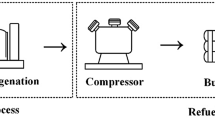The article presents an effective solution to the problem of increasing the degree of water and oxygen conversion from the crew’s waste products for interplanetary manned flights. The currently used water and oxygen regeneration complexes use the method of high-temperature electrolysis of carbon dioxide and water with a cyclic reaction of hydrogenation of carbon monoxide to methane, thus enabling the conversion rate of up to 61%. In this case, waste is emitted in the form of carbon monoxide (270 g/day), methane (140 g/day), hydrogen (60 g/day), and feces (150 g/day). The proposed method is based on the complete regeneration of water and oxygen in a reactor, in which additional water and higher alkanes are obtained from the waste of existing regeneration complexes by the action of low-temperature plasma in the presence of catalysts from hydrocarbons. The as-obtained products can be used on the International Space Station as plant fertilizers, as well as for the synthesis and biosynthesis of organic substances in demand, such as glucose. The proposed reactor implements a complete closed cycle of water conversion at a space station, thereby reducing the amount of waste, delivered cargo, and consumables necessary for interplanetary expeditions.

Similar content being viewed by others
References
G. I. Voronin and A. I. Polivoda, Life Support for Crews of Space Ships [in Russian], Mashinostroenie, Moscow (1967).
V. N. Serebryakov, Fundamentals of Designing Life Support Systems for Spacecraft Crews [in Russian], Mashinostroenie, Moscow (1983).
State Standard GOST R 50804–95 Cosmonaut’s Habitable Environments on Board of Manned Spacecraft. General Medicotechnical Requirements [in Russian], Gosstandart Rossii, Moscow (1995).
A. S. Guzenberg, A. G. Zheleznyakov, S. Yu. Romanov, A. A. Telegin, and A. V. Yurgin, “Selecting life support system for the crews of long duration space stations” [in Russian], Kosmicheskaya tekhnika i tekhnologii, No. 1, 67–80 (2015).
A. G. Zheleznyakov, S. A. Glukhikh, A. S. Guzenberg, S. Yu. Romanov, A. V. Yurgin, and A. M. Ryabkin, “ Use of methane in closed-loop life support systems for space missions” [in Russian], Kosmicheskaya tekhnika i tekhnologii, No. 4, 78–92 (2021); DOI: https://doi.org/10.33950/spacetech-2308-7625-2021-4-78-92.
S. Yu. Romanov, A. S. Guzenberg, and A. M. Ryabkin, “Crew life support system concept for interplanetary missions” [in Russian], Kosmicheskaya tekhnika i tekhnologii, No. 3, 80–97 (2017).
Author information
Authors and Affiliations
Corresponding author
Additional information
Translated from Khimicheskoe i Neftegazovoe Mashinostroenie, Vol. 58, No. 12, pp. 22–24, December, 2022
Rights and permissions
Springer Nature or its licensor (e.g. a society or other partner) holds exclusive rights to this article under a publishing agreement with the author(s) or other rightsholder(s); author self-archiving of the accepted manuscript version of this article is solely governed by the terms of such publishing agreement and applicable law.
About this article
Cite this article
Galkin, M.L., Kazakova, A.A. Conversion of Hydrocarbons and Water in Closed Life Support Systems for Interplanetary Flights. Chem Petrol Eng 58, 1030–1034 (2023). https://doi.org/10.1007/s10556-023-01195-4
Published:
Issue Date:
DOI: https://doi.org/10.1007/s10556-023-01195-4



